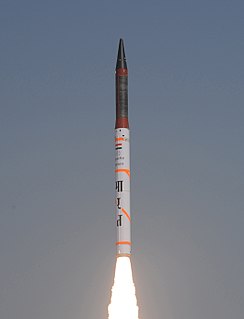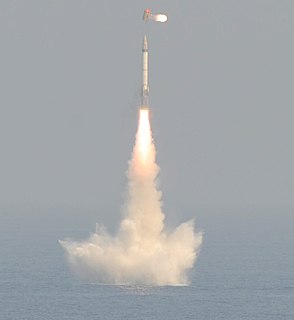 W
WAgni-I is a short-range ballistic missile that was developed by DRDO of India in the Integrated Guided Missile Development Program. It is a single-stage missile that was developed after the Kargil War to fill the gap between the 250 km (160-mile) range of the Prithvi-II missile and the 2,500 km (1,600-mile) range of the Agni-II. It was first launched from a road mobile launcher at Integrated Test Range (ITR), Wheeler Island, on 25 January 2002. Less than 75 launchers are deployed.
 W
WAgni-II, is the second strategic ballistic missile of Agni (missile) family envisaged to be the mainstay of the Indian missile-based strategic nuclear deterrence. The Agni-II is a medium-range ballistic missile (MRBM) with two solid fuel stages and a Post Boost Vehicle (PBV) integrated into the missile's Re-entry Vehicle (RV). The Agni's manoeuvring RV is made of a carbon-carbon composite material that is light and able to sustain high thermal stresses of re-entry, in a variety of trajectories. The Agni-IIA is a more advanced version of Agni-II, albeit with more sophisticated and lighter materials, yielding a better range and operating regime. Agni-IIA was later renamed as Agni-IV plugging the gap between Agni-II and Agni-III. While the first test of Agni-IV in December 2010 was a failure, the second test flight in November 2011 was a success Agni-II, developed as part of medium- and long-range Agni series of missile systems, has already been inducted into the Armed Forces.
 W
WThe Agni-III is an Indian intermediate-range ballistic missile inducted into service in 2011 as the successor of the Agni-II. It has a range of 3,000 to 5,000 kilometres and can reach targets deep inside neighbouring countries including China.
 W
WAgni-IV ("Fire") is the fourth in the Agni series of missiles which was earlier known as Agni II prime. It has been developed by India's DRDO and displayed a number of new technologies and significant improvement in missile technology. The missile is light-weight and has two stages of solid propulsion and a payload with re-entry heat shield. With 3,500 to 4,000 km range, it is capable of striking targets in nearly all of mainland China, if launched from northeastern part of India.
 W
WAgni-V is an Indian nuclear-capable ballistic missile developed by the Defence Research and Development Organisation (DRDO). The missile is believed to have a range of around 5,000 to 8,000 kilometers. Indian officials describe it as an intercontinental missile, or ICBM, even though its tested range only qualifies it as an intermediate range missile. It is a three-stage, road-mobile and solid-fuelled missile which is transported by a truck and launched via a canister. Its first flight was conducted in 2012.
 W
WPrithvi is a tactical surface-to-surface short-range ballistic missile (SRBM) developed by Defence Research and Development Organisation (DRDO) of India under the Integrated Guided Missile Development Program (IGMDP). It is deployed by India's Strategic Forces Command.
 W
WPrahaar ("Strike") is an Indian solid-fuel road-mobile tactical ballistic missile developed by the Defence Research and Development Organisation (DRDO). Prahaar is expected to replace the Prithvi-I short-range ballistic missile in Indian service.
 W
WPrithvi is a tactical surface-to-surface short-range ballistic missile (SRBM) developed by Defence Research and Development Organisation (DRDO) of India under the Integrated Guided Missile Development Program (IGMDP). It is deployed by India's Strategic Forces Command.
 W
WSagarika, also known by the code names K-15 or B-05, is an Indian submarine-launched ballistic missile (SLBM) with a range of 750 kilometres (466 mi) that was designed for retaliatory nuclear strikes. It belongs to the K Missile family and forms a part of India's nuclear triad.